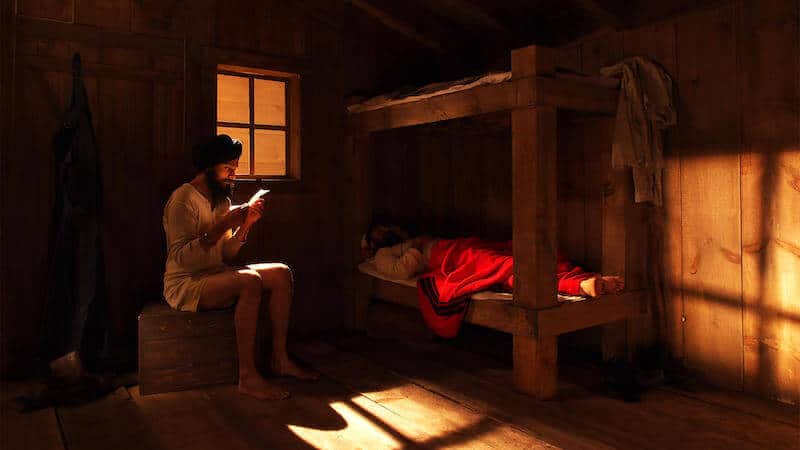Being Shabana Azmi
The celebrated Indian actor/activist in conversationShare Article
Shabana Azmi, one of India's pre-eminent actors, was in Vancouver (October, 1994) on the invitation of NRISAD (Non-Resident Indians for Secularism and Democracy) and the Pacific Cinematheque, where a retrospective of her films was being held. In the following conversation with Ameen Merchant, she reflects on her film career, her politics and her experiences as a social activist.
Ameen: This is something I've always wondered about. Does a successful actor ever stop acting? I mean, where does Shabana the person end and Shabana the persona begin?
Shabana: See, I am a sum total of the parts that I play and I've always believed that acting is a two-way process. Every time I portray a character I learn something different, something new. So Shabana the person brings something to that character and simultaneously learns something about the character, a different way of comprehending the world, perhaps. I feel very strongly about this. Because, you see, the more I add to my experience as an actress who plays particular characters and gets involved in particular situations, the more enriched, I, Shabana the person, become. Similarly the more aware I keep myself, the more open I am to life's experiences, the more it helps me in understanding a Lakshmi [the character in Ankur] or a Jeroo [the character in Pestonjee] or whoever I think the problem with most actor-stars is that they start getting cut off from life. They have their own private make-up man, hairdresser, assistant and in the evening after wrap-up they attend the same kind of parties where everybody reinforces their view of themselves...and they get stuck. They are unable to travel by cabs or speak to a bhajiwali or interact with the real people they are supposedly portraying... It cuts off their greatest resource from where they should be getting their acting. So if you ask me who I am, I think that I am all these parts, but my strength lies, I think, in the fact that I have not become cynical. I don't have all the answers and I am hugely curious and hugely interested.
my strength lies, I think, in the fact that I have not become cynical. I don't have all the answers and I am hugely curious and hugely interested
Ameen: So, who was the most difficult character to portray? Which do you consider your most challenging role to date?
Shabana: You know, the one person that I was really surprised to discover in myself was Jamini, the character I played in Mrinal Sen's Khandar. To find Jamini, I had to go deep inside the recesses of my own being and, when I did, I was actually startled to discover that she actually existed.
Ameen: How do you get in touch with someone who you think exists within you? How do you isolate this person? Is there a process?
Shabana: The first time you hear a story is very important—whether it is narrated in three lines or as an entire script. The first narration is very important for me for something clicks during that time. Mrinal'da narrated the story to me in five lines— and something pulled me to that character and I said, "Yes, this could be challenging." What happened is that Khandar came immediately after Mandi. And for Mandi, I had put on weight and was very gregarious on the sets and it was one bigjhamela...and in three weeks I was reporting for Khandar, set in these ruins in Shanti Niketan. And very subconsciously—it is only in retrospect that I am able to understand this—I decided that I was going to be by myself; no make-up man, no hairdresser, no nothing, just my books and my music. It was as though I had decided to withdraw from life's experiences. For with Mandi I had expanded the barriers of my own persona and I had to find the quiet, tragic but dignified Jamini from somewhere within. So it was a very reserved Shabana on those sets. Looking back, I realize that it also had to do with the ruins. You know, they do something to you. You really get affected by your environment.
Ameen: What about a film like City of Joy? What kind of challenge did that pose?
Shabana: Firstly, the chance to work with Roland Joffe. That I wanted very much. And when I met Roland, I saw that he was really concerned; that his heart was in the right place. Regarding the film's reception, I feel that as Indians we tend to get very hyper about being seen in any kind of negative light, and we think that being shown as being poor is somehow wrong. You know, we should really be concerned with this issue and not try to hide it under the carpet all the time. And also this criticism about this American doctor teaching these Indians to stand on their own feet...Well, you should understand that a film like City of Joy is a huge commercial consideration—you have to accept that—without which the film would have never been made. Nobody in America is interested in a film about slum-dwellers from God knows where. People aren't interested. So, that's a concession you make. But in any case, I know—I work in the Bombay slums constantly—that whether it is a village or the city slums, you need a catalyst, you need somebody from outside who comes in and works and inevitably becomes a catalyst for change. In some cases, people from the same environment arise and become catalysts, but you need that kind of consciousness-raising. For instance, in Mijmawe where my father is working, had my father not taken on the role of being the social activist that he is, that village would have remained frozen in time. So, if City of Joy had an Indian doctor, say a doctor from Bombay, how would it have been different, except that uski chamdi gori hai?
Ameen: But what about the media in the West, one that is saturated with negative stereotypes of India, and the ramifications such a film may have for the diasporic South Asian community—especially in North America? Doesn't the film consolidate such a discourse?
Shabana: That's a different perspective and of course I'm aware of all this. But I personally think that there was too much self-flagellation in the film.
The doctor kept feeling like a piece of shit all the time only because his father had not been nice to him and, in coming to India, coming to the slum and getting to know the rickshawwallah, he realizes that there are different values existing here, for Christ's sake, the family being the most important of them. Here the rickshawwallah's family depends on his daily income and every decision that is made is not for the individual but for the whole family, which is completely different from the West where everything is for the individual. So, I see the film as portraying a learning experience both ways. I didn't think it was only Patrick Swayze playing God, in fact if anything, I think the film leaned far more heavily on the side of Om Puri and made him more angelic than was necessary.
Ameen: What about the question of availability? There is this experience of a whole different value system that's available to the American that just does not exist for someone from that part of the world?
Shabana: Tho kya kare uska? Kya kare?
Ameen: Isn't it exploitative?
Shabana: You know, Roland's heart would break if he heard this. These are pre-fixed notions that are now being imposed on the film. Because, if anything, he was seeking to do the exact opposite.
Ameen: You can't overlook the colonial paradigm here. The white man goes to the East, confronts and constructs his identity in an exotic locale, and returns fully aware of himself. The piece about you in The Vancouver Sun was captioned: "A Passage to the Films of India"! Why flog these colonial cliches? Doesn't the film similarly set up the racial 'Us and Them' divide?
Shabana: In fact, what the filmmaker attempts to do in City of Joy is that he tries to resolve this 'Us and Them' by saying that yes, there is the 'Other' most certainly, but the 'Other' and 'Us' can be celebrated without the need for subjugation. I think the film is about understanding each other. Of course, there is the divide, and when you use the colonial yardstick it is very easy to impose that structure on the film.
Ameen: I think there is a difference between imposing and recognizing. Forme, City of Joy was yet another film about India's poverty, filth and backwardness. There was absolutely no trace of a modern nation.
Shabana: I really don't see the subject as a problem. But you're right, I too would have liked to see—which unfortunately could not be available within the context of the narrative—the contradictions of India. The fact that people live in several centuries simultaneously—we didn't get a glimpse of that. If we'd had a glimpse of that, then it would have been more interesting.
Ameen: On that note of centuries, what are your views on the present-day communal situation in India?
Shabana: See, it was the first time in my life that I had the word 'Muslim' hurled at me, either sympathetically or aggressively, but with a self-consciousness. It had never, never, never happened. And it brought into play this whole issue of 'identity.' And identity is based on so many things. If you ask me who I am, the first thing that I would say that I am a woman, then I'd say I'm an Indian, that I'm an actress, an activist, a Muslim, a daughter, a wife etcetera, etcetera. But in India it seems almost as though a systematic attempt is being made to push 'identity' into the narrow confines of the religion one belongs to, so that you become a Hindu, she becomes a Christian, he becomes a Sikh and I become a Muslim—and that's it! All the other identities are blurred. Now, that is the sharpest thing that is happening and it is very hard to deal with because obviously what you are doing is attacking India's composite culture, which is its strongest point. And for me it has been a very traumatic and extremely painful period, for it just slipped in so unobtrusively into areas where I sense this being a 'Muslim' all around me.
See, I come from a family where—left background yeh woh—we've celebrated Diwali, Holi, Idd, Christmas—all with the same fervour. Our family has been the centre for these things. Now, after the riots, Holi was the first festival to be celebrated— it came just immediately after the Bombay riots. And, palpably, in the air around me, I could sense a feeling of apprehension, even in my closest friends. Will they celebrate this year or not? And the fact that we did made them heave a sigh of relief. But that to me was the greatest tragedy. For here was something that I had always taken for granted as part of my composite culture and now it had become a token of my secular s credentials! I couldn't deal with it. Even as I tell you now it gives me gooseflesh: that just because I celebrated Holi you acknowledge me as a secular liberal? That was an eye-opener. And the divide is so deep along communal lines, particularly amongst the middle classes, the largest segment of the Indian population. The madness has, of course, died down but the tension is still there. The minorities feel very vulnerable and insecure.
Ameen: Is there any coalition building among the minorities to combat this divide?
Shabana: Yes. For starters, the Muslim liberal—who did not want to get involved, perhaps for the fear of being called communal—and was too busy establishing his secular credentials when Muslims were being butchered in Muradabad, killed in Malyana, hounded in Bhiwandi—this Muslim liberal kept away. For whatever token reason, the Shahi Imam and Syed Shabuddin were people who took up the cause of the Muslims. Now obviously, the Muslim community began to regard these people as saviours as the Muslim liberal never spoke for the community. But when on Salman Rushdie and Shah Bano this Muslim liberal gets up and says: "Meri baat suno, unki baat mat suno" the community says, "Go away! Where were you when my children were being killed? Where were you when my hut was being burnt? Why should I listen to you now? Go away from here!" Finally, after the demolition of the Babri Masjid and the massacre that followed, the Muslim liberal has woken up, and has decided to take charge, so to speak. Because in not doing, a lot has been done. So, for the first time there's an emerging Muslim leadership, and a different, committed voice is being heard.
Ameen: Have you personally been involved in any of these movements? How have you tackled this issue?
Shabana: We, that's Nirvara Haq, the organization I am involved with, figured that communal harmony cannot be achieved by shouting slogans. It can only be achieved by relating it to issues of social justice. And it is social justice we have been fighting for in the slums, and, in the process, making it amply evident to the slum-dwellers that their security lies in having a harmonious relationship with those around them rather than an antagonistic one. For instance, take the Shahi Imam. Who is he to issue a fatwa? But he does so occasionally and instructs Muslims to vote for so-and-so of such-and-such party. Achcha bhai, agaruski itni standing hai community mein, then that party should get the votes. But the fact is that most of the candidates whom he recommends lose even their election deposits! So, this shows very clearly that the Shahi Imam is not the leader of the community. The curious thing is that the media does not focus on thisfact as much as it pretends to set-up the Shahi Imam as the sole spokesman of the Muslim community. Why does it not make the headlines that when he issued a fatwa, his candidates lost? This lie has to be exposed. But that's not happening. That's just the first fact. On the other hand, there are very strong secular Hindu groups that have been struggling sincerely to uphold secularism and democracy. They really need to be strengthened. Because see, what is Hindu Rashtra? Hindu Rashtra is the antithesis of Akhand Bharat and so if Sikh fundamentalism and Muslim extremism are considered anti-national how can Hindu fundamentalism be considered national? How can you ignore the hatred it is expressing towards so many others in the country? So Hindu fundamentalism cannot hide its face under the mask of nationalism. That bogey has to be burst. And a lot of work is happening in the area. But again, until the silent majority gets up and speaks, not much headway is going to be made.
Ameen: Now which is this 'silent majority'?
Shabana: Oh, the silent majority is a lot of people who are not communal but who never get up and speak. The kind of people who think that, "Bhai hum tho communal nahin hai tho, why should we get involved in this whole chakkar?" But this time such apathy won't do. That's why it is very important that the secular liberals, like we call ourselves, have to stop preaching to the already converted. Please let's stop that and let's now get people who are sitting on the fence, the people who do not want to get involved, involved. And one of the strongest ways of doing that is through culture. Because you see, people are not interested in joining you for marches to raise their hands or for that matter taking on confrontationist positions and demonstrating strong political attitudes. They want to keep away from all that. But yes, they are interested in culture. So that becomes a window through which you can definitely enter.
Because you see, people are not interested in joining you for marches to raise their hands or for that matter taking on confrontationist positions and demonstrating strong political attitudes. They want to keep away from all that. But yes, they are interested in culture. So that becomes a window through which you can definitely enter.
Ameen: What do you mean by 'culture'? And how does this happen?
Shabana: By culture, I mean dance, drama, theatre, literature, cinema—the whole works. RSS ko dekho, no kya kiya hua hai...RSS is one huge organizational success story, isn't it, basically? Of course, the other thing that needs to be done is that this revisionist propaganda has to be countered. There has been a systematic campaign of hatred for the last sixty odd years that has been absolutely inculcated and we haven't realized how viciously propaganda can lodge itself in the hearts of people to replace information. Propaganda then becomes your information. And when it isn't countered, then it can have very, very dangerous consequences. For far too long the secular liberal behat ke bhaiyya has thought that propaganda is so obvious it doesn't need countering. It is because of such an attitude that things have come to such a crisis. Frankly, in my view, the fight is now between organization and disorganization. The secular liberal is not organized and the communal element is far more organized and has a much greater outreach. I saw this for myself last year when I was in the USA. It was through celebrating the Vivekanand Centenary, organizing picnics for children, funmelas for women, camps for the older community members—it was through these activities that all these in-roads were being made into 'Hindu Nationalism' in inverted commas, 'Hindutva' to be more specific.
But you see, Hinduism is a very tolerant, all-encompassing religion. So how then can you say that the preachers of the 'Hindutva' are talking about the same Hinduism of Vivekanand or Gandhi? How do you come to terms with that? You have to burst that bogey again.
communalism is basically an ideological and political method. History is used inevitably... to catalogue a list of imaginary and real grievances in the past that require redress in the present.
Ameen: Yes. But then again, the very identity of the nation, 'Hindustan' as it is called, becomes a convenient rationale, don't you think?
Shabana: Yes, that might be true. But on the other hand, the Muslim says, "I had a choice to go to Pakistan and I didn't go as I believed that you were going to provide me security and secularism, here in India, for keeps. So why should I, who has chosen to stay back, and my children and my children's children constantly have to give proof of our loyalty to this nation?" We have to understand that this is happening because communalism is basically an ideological and political method. History is used inevitably as political rhetoric to catalogue a list of imaginary and real grievances in the past that require redress in the present. Thus it becomes the means for contemporary political mobilization—which is what the whole Babri Masjid issue did become. So, it's very important to make the common man see the design behind all this, for it is the common man who paid the price in the Bombay riots, not the people who designed this whole scheme. Let me give you an example. You know the Babri Masjid was demolished on the 6th of December. On the 29th, my husband Javed and I were in a slum in Bharat Nagar, and we met a woman from the slum whose sister was killed in the riots. I asked her, I said "Why was your sister killed?" and she said, "Woh danga hua tha na," and so I said, "Why did that happen, that riot?" She thought for a bit and said "Woh koi masjid thi na kahin, woh thod dali Hindu log ne." So I said, "Do you know where that masjid is?" She thought and said "Rajiv Gandhi ke muluk mein." And I said, "Rajiv Gandhi ka muluk kahan hai?" She hesitantly said "Nayi Dilli, shayed?" This was how far the issue of the Babri Masjid was from her reality and her understanding and yet she was paying with her sister's life for it! That is really the big tragedy.












